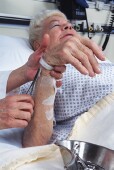
WEDNESDAY, Jan. 22, 2014 (HealthDay News) — Efforts to reduce “adverse events” that occur in the hospital appear to be taking hold for patients who’ve had a heart attack or those being treated for congestive heart failure, according to new research.
Adverse events include reactions to certain drugs, falls, bedsores, hospital-acquired infections, and complications that occur after a procedure or surgery.
Over the past decade, reducing the rate of such in-hospital events has become a priority, and this study shows progress. Between 2005 and 2011, the rate dropped 25 percent and 28 percent for heart attack and congestive heart failure patients, respectively.
But, the news wasn’t as good for people hospitalized with pneumonia or surgical patients. The overall rate of adverse events stayed the same between 2005 and 2011 for those groups.
“There’s been a lot of attention focused on patient safety, and this paper shows that some of these problems are getting better,” said Noel Eldridge, a study co-author and public health specialist at the Agency for Healthcare Research and Quality. “When you look at all four groups together, the adverse event rate was going down by 4.7 percent a year. But, while things are definitely getting better, this problem isn’t solved yet.”
Results of the study are published in the Jan. 23 issue of the New England Journal of Medicine.
The study used data from the Medicare Patient Safety Monitoring System, which included information on nearly 62,000 patients who were hospitalized for one of four reasons: heart attack, congestive heart failure, pneumonia or surgery. The system looks for 21 different adverse events.
The data were collected between 2005 and 2011, with the exception of 2008.
For heart attack patients, the rate of adverse events dropped from 5 percent to 3.7 percent during the study time frame, researchers reported. The proportion of heart attack patients with one or more adverse events also declined, from 26 percent to just over 19 percent.
Among congestive heart failure patients, the rate of adverse events dropped from 3.7 percent to 2.7 percent. The proportion of congestive heart failure patients with one or more adverse events went down from 17.5 percent to about 14 percent, according to the study.
The researchers found no significant differences in the overall rates of adverse events for pneumonia and surgery patients.
However, that doesn’t mean the news was all bad for those patients. Pneumonia and surgical patients saw some improvements in adverse drug events and in certain hospital-acquired infections.
And, conversely, the news wasn’t all good for heart attack and congestive heart failure patients, the report indicated.
The percentage of patients developing bedsores or ventilator-assisted pneumonia increased in heart attack patients from 2005 to 2011. Rates of kidney problems linked to the contrast material used in heart procedures also increased in heart attack patients. And, in congestive heart failure patients, mechanical problems related to central catheters increased in the study period.
“Health care providers are working very hard to make a difference and this study shows we have made a difference,” said Dr. Linda Ellis, an associate professor of medical sciences at the Quinnipiac University School of Medicine in North Haven, Conn. “Certainly, more improvements can be made, but we’re working on it,” she added.
Ellis said it’s hard to tease out why the heart patients appeared to improve overall while the pneumonia and surgical patients didn’t. “All of these measures of adverse events that they’re looking at can have a lot of variables,” she noted. “There could be differences from hospital to hospital. There are so many things that affect patient safety that it’s not easy to pinpoint and focus on one factor.”
But, Ellis added that “communication between providers can make a big difference in patient safety. Teamwork is huge.”
Study author Eldridge said it’s hard to know from the current data what accounts for the improvement in heart patient safety.
“We really need to dive into the data to see what made a difference,” Eldridge said. “We need to dissect what happened with the different types of adverse events. Sometimes, when you look at the whole picture, it may hide improvements and successes in some areas,” he explained.
Both Eldridge and Ellis noted that the good news from this study is that there has been progress in improving patient safety, and that patient safety continues to be a focus for health care providers.
More information
Read about staying safe as a patient at the Agency for Healthcare Research and Quality.
Copyright © 2025 HealthDay. All rights reserved.

